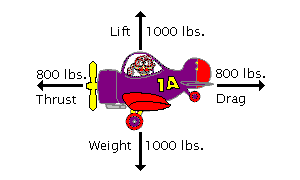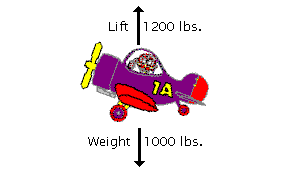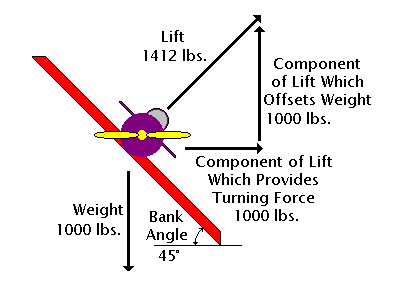
Basic Aerodynamics
This is the traditional starting point for almost any discussion of flight aerodynamics I have ever seen. If we are to accept Sir Isaac Newton’s contributions to modern physics, then there are several immutable truths. An aircraft in level, unaccelerated flight (constant speed, constant direction, constant altitude) must have an amount of lift exactly equal to its weight and must produce thrust exactly equal to its drag:

Now, of course, if any of these forces are varied, acceleration occurs. For example, if the lift exceeds the weight of the aircraft, it will climb, or if the thrust exceeds the drag, it will increase its forward velocity. It is left as an exercise to the reader to determine the effect of the inverses of those conditions.
| Here is a climb: | This is a dive: |
 |
 |
Now that we can climb, dive, and vary speed, what about turning? Unlike ground vehicles which derive their motive forces via the contact of wheels with road or rail, an aircraft must depend on its wing (and tail) surfaces to develop aerodynamic forces to achieve the desired result. In order to turn, an aircraft must roll into a bank to develop a component of its lift force in the direction of the desired turn. The lift of a wing is developed at right angles to its surface, so banking the aircraft tilts the lift "vector" away from the vertical by the amount of the bank angle. The following head-on illustration of my little purple airplane will illustrate this:

Forgive a small amount of math, but if this turn is made at constant altitude and at constant forward speed we can calculate that the lift required to support the weight of the aircraft is:
L = W / Cos x , where W is the weight and x is the bank angle.
Also, the centripetal force, which is the horizontal component providing the turning force is:
T = W / Sin x , where W is the weight and x is the bank angle.
We could also express these relationships in terms of acceleration units, or "Gs". A "G" is simply the accleration due to gravity. Force is mass x acceleration, so if the mass of the aircraft is m, and the acceleration due to gravity is G, then we can restate the first relationship as:
m LA = mG / Cos x, where LA is the net acceleration perpendicular to the surface of the wing.
Note that the mass term may be divided out of both sides of the expression which leaves us with:
LA = G / Cos x
The acceleration experienced by the aircraft (and its pilot) in the direction perpendicular to the wing is thus independent of aircraft mass and velocity and is solely determined by the bank angle. That one bears repeating. Regardless of the aircraft type, its altitude, the density of the air, the temperature, or any other factor, the G-load (or Load Factor) experienced by the aircraft and pilot is related only to the bank angle. A Cessna 150 at 100 knots in a 60° bank will experience 2 G as will an F-16 at 500 knots at the same bank angle.
Here is a little table for various bank angles:
| Bank Angle | Acceleration |
| 10° | 1.02 G |
| 20° | 1.06 G |
| 30° | 1.15 G |
| 40° | 1.31 G |
| 50° | 1.56 G |
| 60° | 2.00 G |
| 70° | 2.92 G |
| 80° | 5.76 G |
| 85° | 11.47 G |
| 87° | 19.11 G |
From this table, it can easily be seen why normal passenger aircraft generally limit bank angle to 30° - 35°. The structural limit for symmetrical G loading in most large aircraft (Boeing 727, C-141) is 2.5 G, a T-38 is rated for 7.33 G, while an F-16 can sustain 12 G. The big problem at the higher G loads is the pilot. In a normal, erect seating position, 6 -7 Gs can be tolerated for only limited amounts of time. In order to get to 12 Gs, the pilot must be in a recumbent position (as is the case for an F-16). In many high performance aircraft it is possible to exceed the structural design limits over a wide range of the flight "envelope" and these machines have G meters as one of the cockpit instruments. The flight envelope of an aircraft is simply the region of altitude and airspeed in which it can be operated.